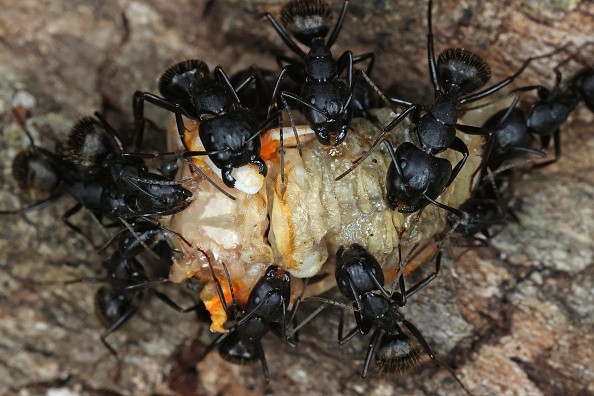Ants live in large groups organized according to the division of very specific tasks. This is a phenomenon that biologists call "sociality."
There are three "casts," each with a different role.
The queen of the colony lays eggs, the male ants (drones) fertilizes them, and the worker bees take care each of their offspring, searching for food and build their nests.
The complexity of ant colonial association is observed not only in actions but also in form. Thus, a winged female takes on the role of queen, and a wingless, sterile female takes on the duty of a worker.
Cretaceous amber with ant pupa found for the first time
According to Earth, a new study led by the University of Jena in Germany inspecting fossils enclosed by amber showed a potentiality of a communal way of life in the early Cretaceous (145 to 100 BC, 5 million times).
During their work, biologists scrutinized four fossils surrounded by amber.
These were three adult female wingless ants and an incompletely developed pupa, the first ant pupa ever found in Cretaceous amber.
"With the help of microcomputer tomographic images, we were able to confirm that the soft parts of the insects were very well preserved," explained by Brendon E. Budinot via EurekAlert. He is currently working on a Humboldt research at the University of Jena.
"For instance, we were suitable to examine the exact framework of the brain and side muscle filaments and compare the four preparations in detail."
Read more : Ants: Our Saviors from Climate Change?
Newfound information on the ant evolution

Research on four fossil ants has provided scientists with a wealth of information available at high-resolution image processing facilities.
Boudinot gained new insights into the development of the internal structure of fossil insects and elucidate the relationships between fossil species and those that are currently alive.
For example, there are questions on how did two different female forms of ants--the queen and the worker--evolve; did the feathers degenerate first before giving birth; did the onset of infertility lead to feather loss, or did both developments occur at the same time?
Thanks to new discoveries and methods, scientists were soon able to answer such questions about the evolution of ants.
In the field of sociobiology, there are also questions of related new research, for instance, the emergence of sociality.
Thus, fossils give the first significant proof of collaborative action from the Cretaceous.
These ants took care of the children together, foraged together, and had different queen and worker castes.
Among modern ants and their close relatives, scientists have confirmed that ants' special social systems evolved sometime in the early Cretaceous, around the time of dinosaurs.
Importance of ants in the environment
According to the paper entitled "Ant biodiversity and its relationship to ecosystem functioning," ants are an important component of the ecosystem because they not only make up the majority of animal biomass, but also act as ecosystem engineers.
The biodiversity of ants is incredibly high, and these organisms are very sensitive to human influences and clearly reduce their abundance.
However, it is not clear how such disruptions affect the maintenance of ant services to the ecosystem.
Ants are important in underground processes due to their effects on plants, microorganisms, and other soil organisms that change the physical and chemical environment.
Also read: These Ants Are Natural-Born Heroes
© 2025 NatureWorldNews.com All rights reserved. Do not reproduce without permission.





